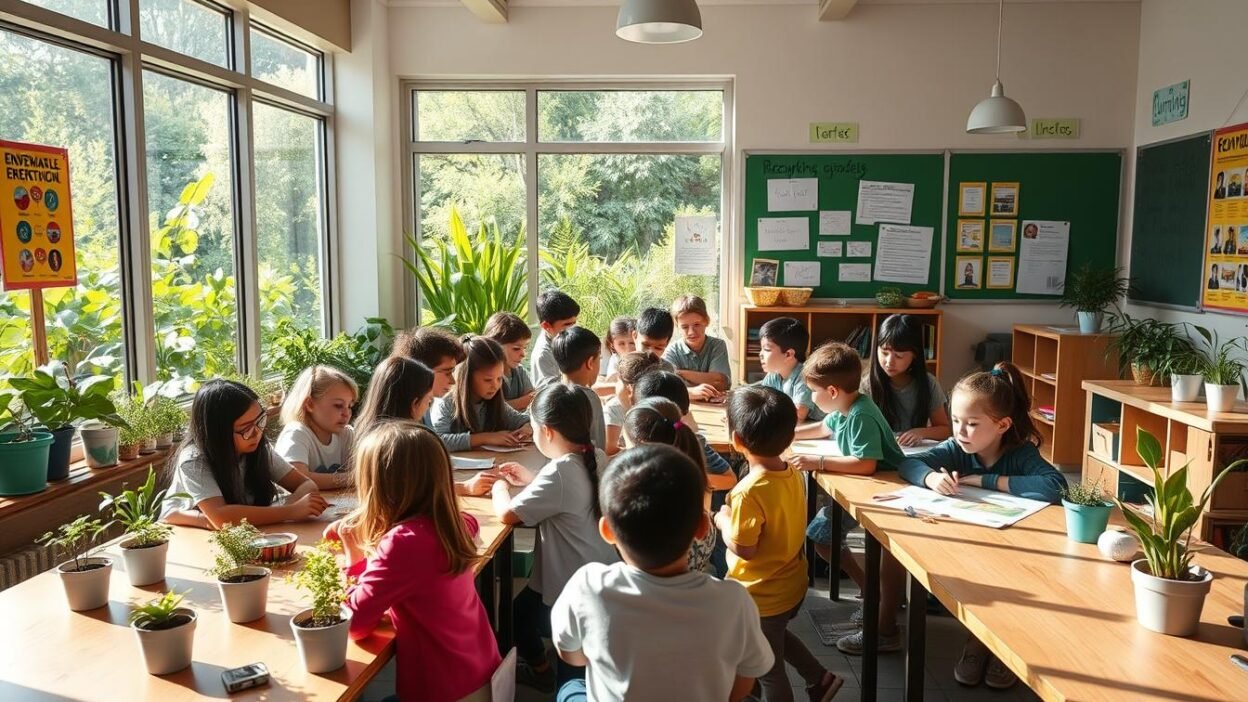Did you know that 91% of students believe their schools should actively incorporate environmental and sustainability concepts into the curriculum? As the world grapples with pressing ecological challenges, environmental protection laws are not only safeguarding our planet but also revolutionizing the landscape of modern education. These regulations are bridging the gap between theory and practice, empowering students to become eco-conscious leaders of tomorrow.
Environmental education has emerged as a crucial component of sustainability efforts, equipping future generations with the knowledge and skills necessary to address complex environmental issues. By integrating sustainability principles into educational systems, schools are nurturing a new wave of environmentally literate citizens who are prepared to tackle the challenges of the 21st century.
This article delves into the profound impact of environmental protection laws on modern education, examining how these regulations are transforming curricula, fostering eco-conscious learning, and shaping future environmental leaders. Through an exploration of innovative teaching methods, community involvement, and the role of technology, we will uncover the critical role education plays in promoting a more sustainable future.
Preparing for the UGC NET exam can be a daunting task, but with the right resources, candidates can navigate the process effectively. Websites like MyJRF provide a comprehensive platform for aspiring educators, offering specialized guidance for UGC NET Paper 2 preparation and essential tips for acing UGC NET Paper 1. Additionally, understanding the revised syllabus provided by UGC is crucial for a targeted study approach. For official announcements and updates, candidates should regularly visit the UGC NET NTA portal, while the UGC’s job section and the main UGC website are invaluable for post-exam opportunities and academic resources. With these tools, candidates can maximize their preparation and set themselves up for success.
Key Takeaways:
- Environmental protection laws are transforming modern education by integrating sustainability principles into curricula.
- Eco-conscious learning is vital for preparing students to address complex environmental challenges.
- Schools are nurturing future environmental leaders through innovative teaching methods and community involvement.
- Technology plays a crucial role in promoting environmental awareness and accessibility to eco-learning resources.
- Education is a key driver in achieving a more sustainable future and addressing pressing ecological issues.
Overview of Environmental Protection Laws
Environmental protection laws play a crucial role in safeguarding our planet’s natural resources and promoting sustainable practices. These environmental regulations and environmental statutes have evolved over time to address the growing challenges faced by our ecosystems. By establishing a robust environmental policy framework, governments aim to ensure environmental compliance and mitigate the impact of human activities on the environment.
Importance of Environmental Legislation
Environmental legislation serves as the foundation for protecting our planet’s biodiversity, air and water quality, and natural habitats. These laws not only regulate industrial practices and waste management but also promote conservation efforts and sustainable resource utilization. By setting clear guidelines and penalties for non-compliance, environmental protection laws help to hold individuals and organizations accountable for their actions and encourage responsible behavior.
Key Milestones in Environmental Law
Throughout history, several landmark pieces of legislation have shaped the landscape of environmental protection. Here are some notable milestones:
| Year | Legislation | Key Provisions |
|---|---|---|
| 1970 | National Environmental Policy Act | Requires federal agencies to assess environmental impacts of proposed actions |
| 1970 | Clean Air Act | Regulates air emissions from stationary and mobile sources to protect public health |
| 1972 | Clean Water Act | Establishes the structure for regulating pollutant discharges into U.S. waters |
| 1973 | Endangered Species Act | Protects threatened and endangered plants and animals and their habitats |
Current Environmental Challenges
Despite the progress made through environmental legislation, our planet still faces significant challenges. Climate change, deforestation, plastic pollution, and loss of biodiversity are just a few of the pressing issues that demand urgent attention. As environmental policy evolves to address these challenges, it is crucial to prioritize education and awareness to foster a culture of environmental compliance and stewardship.
“The Earth is what we all have in common.” – Wendell Berry
By understanding the importance of environmental protection laws and actively engaging in sustainable practices, we can work towards a greener, healthier future for generations to come.
The Role of Education in Environmental Protection
Education is a powerful tool in the fight for environmental protection. By integrating environmental studies into school curricula, we can equip the next generation with the knowledge and skills needed to become responsible stewards of our planet. Through sustainability education, students gain a deeper understanding of the complex issues facing our environment and the actions they can take to make a positive impact.
One key aspect of environmental education is promoting eco-literacy among students. This involves teaching them about the interconnectedness of ecosystems, the importance of biodiversity, and the impact of human activities on the environment. By fostering environmental awareness from a young age, we can encourage students to adopt sustainable practices and make informed decisions that benefit the planet.
Integrating Environmental Studies into Curricula
To effectively integrate environmental studies into school curricula, educators must take a multidisciplinary approach. This means incorporating environmental themes into various subjects, such as science, social studies, and even language arts. By doing so, students can develop a holistic understanding of environmental issues and their relevance to different aspects of life.
Some examples of how environmental studies can be integrated into curricula include:
- Exploring the science behind climate change and its impacts on ecosystems
- Analyzing the social and economic factors that contribute to environmental degradation
- Discussing the role of literature and art in raising environmental awareness
Promoting Environmental Awareness Among Students
In addition to integrating environmental studies into curricula, schools can promote environmental awareness through various initiatives and activities. These may include:
- Organizing eco-friendly campaigns, such as waste reduction and recycling programs
- Encouraging student participation in environmental clubs and projects
- Inviting guest speakers from environmental organizations to share their expertise
- Organizing field trips to nature reserves, recycling facilities, or sustainable farms
By engaging students in hands-on activities and real-world experiences, educators can help them develop a deeper appreciation for the environment and a sense of responsibility towards its protection. As Dr. Jane Goodall once said,
“What you do makes a difference, and you have to decide what kind of difference you want to make.”
Case Studies of Effective Environmental Education
Environmental education programs have the power to transform the way students and communities engage with the natural world. By integrating sustainability initiatives into school curricula, these programs foster a deep sense of environmental stewardship and inspire positive change. Let’s explore some remarkable case studies that showcase the impact of effective environmental education.
Successful Programs in Schools
One shining example of a successful environmental education program is the Green Schools Alliance. This initiative brings together schools from around the world to promote sustainability and environmental literacy. Through hands-on projects, eco-challenges, and student-led campaigns, the Green Schools Alliance empowers young learners to become active stewards of the planet.
Another notable program is the Eco-Schools USA, a nationwide initiative that guides schools in adopting sustainable practices and integrating environmental themes into the curriculum. By participating in Eco-Schools USA, students develop critical thinking skills, engage in problem-solving, and learn the importance of responsible citizenship.
“Environmental education is a vital tool for shaping the future. It equips students with the knowledge and skills they need to become responsible global citizens and advocates for a sustainable world.” – Rachel Carson, environmental activist and author
Impact on Local Communities
The benefits of environmental education programs extend far beyond the classroom walls. When students engage in community-based projects and sustainability initiatives, they become catalysts for positive change in their local communities.
For instance, the Earth Partnership for Schools program in Wisconsin has been instrumental in connecting students with their local ecosystems. Through restoration projects, field studies, and community outreach, students develop a deep understanding of the natural world and learn how to become active stewards of their local environment.
Similarly, the Edible Schoolyard Project, founded by chef Alice Waters, has transformed school gardens into vibrant outdoor classrooms. By engaging students in hands-on learning experiences, such as growing and harvesting their own food, this program fosters a strong connection between education, sustainability, and community well-being.
These case studies demonstrate the transformative power of environmental education programs. By nurturing a sense of environmental stewardship and promoting sustainability initiatives, these programs not only enrich the lives of students but also create ripple effects that positively impact local communities and the planet as a whole.
Environmental Protection Laws and Curriculum Development
Environmental protection laws play a crucial role in shaping the content and focus of educational programs. These regulations set standards for curriculum development, ensuring that students receive a comprehensive understanding of environmental issues and the importance of conservation. By incorporating environmental standards into educational content, schools can foster a generation of environmentally conscious citizens.

Regulations Influencing Educational Content
Environmental legislation has a direct impact on the design and implementation of curricula. Laws and regulations establish guidelines for what should be taught in schools, with a focus on promoting environmental awareness and sustainability. For example, some states require schools to include specific topics, such as climate change, renewable energy, and waste management, in their science and social studies curricula.
These regulations ensure that students receive a well-rounded education that prepares them to address the environmental challenges of the future. By setting clear standards for educational content, environmental protection laws help to create a consistent and comprehensive approach to environmental education across the country.
Collaboration with Environmental Organizations
Collaboration between schools and environmental organizations is essential for enhancing the quality and relevance of environmental education. These partnerships provide students with opportunities to engage in hands-on learning experiences, such as field trips, research projects, and community service initiatives.
Environmental organizations can also provide valuable resources and expertise to support curriculum development. By working closely with educators, these organizations can help to create engaging and informative educational content that aligns with environmental standards and best practices. Some examples of successful collaborations include:
- Partnerships between schools and local conservation groups to develop outdoor learning programs
- Collaboration with environmental research institutions to create science-based curriculum materials
- Workshops and training sessions for teachers, led by environmental experts, to enhance their knowledge and skills
Through these partnerships, schools can provide students with a more comprehensive and impactful environmental education, preparing them to become informed and active stewards of the planet.
Innovative Teaching Methods for Environmental Issues
Environmental education has evolved to incorporate innovative teaching methods that engage students and deepen their understanding of critical issues. By adopting creative approaches, educators can transform the way students learn about and interact with the environment.
One highly effective technique is project-based learning. This method involves students working on real-world environmental projects, such as designing sustainable energy solutions or developing community recycling programs. Through these hands-on experiences, students gain practical skills and a deeper appreciation for the complexities of environmental challenges.
Project-Based Learning Techniques
Successful project-based learning initiatives often include the following elements:
- Authentic, relevant environmental issues as project topics
- Collaborative teamwork and problem-solving
- Incorporation of technology and digital tools
- Presentations and demonstrations of project outcomes
“Project-based learning allows students to take ownership of their environmental education. They become active participants in finding solutions and making a difference.” – Sarah Johnson, Environmental Science Teacher
Hands-On Activities and Experiential Learning
Complementing project-based approaches, hands-on activities and experiential education provide students with immersive learning opportunities. These may include:
| Activity | Learning Outcomes |
|---|---|
| Field trips to natural habitats | Observation skills, ecological understanding |
| Lab experiments on environmental processes | Scientific inquiry, data analysis |
| Gardening and composting projects | Sustainable practices, plant life cycles |
| Waste audits and reduction campaigns | Consumer awareness, resource conservation |
By engaging in these hands-on experiences, students develop a tangible connection to environmental concepts and a motivation to take action. Innovative teaching methods like project-based learning and experiential education are transforming the way we prepare the next generation of environmental stewards.
The Impact of Technology on Environmental Education
In the digital age, technology has transformed the landscape of environmental education, offering innovative tools and platforms that enhance learning experiences and raise awareness about pressing ecological issues. By leveraging the power of educational technology, educators can engage students in meaningful ways, fostering a deeper understanding of environmental concepts and inspiring them to become active stewards of our planet.
Digital Tools for Environmental Awareness
Digital tools have revolutionized the way we approach environmental education, making it more interactive, immersive, and accessible. From virtual reality simulations that transport students to fragile ecosystems to mobile apps that allow them to track their carbon footprint, these tools provide hands-on experiences that drive home the importance of environmental conservation. Some notable examples include:
- Virtual field trips to remote locations, such as rainforests and coral reefs
- Augmented reality apps that overlay educational content on real-world environments
- Gamified learning platforms that encourage eco-friendly behaviors and decisions
E-Learning Platforms and Resources
The rise of e-learning platforms has made environmental education more accessible than ever before. These online resources offer a wealth of information, courses, and interactive materials that cater to learners of all ages and backgrounds. From comprehensive online courses on sustainability to webinars featuring leading environmental experts, e-learning platforms provide a convenient and flexible way to acquire knowledge and skills related to environmental protection.
“E-learning has the potential to revolutionize environmental education by breaking down barriers and empowering individuals to take action in their communities.” – Dr. Sarah Thompson, Environmental Education Specialist
Moreover, online environmental resources, such as databases, articles, and multimedia content, serve as valuable supplements to traditional classroom learning. By incorporating these resources into their lessons, educators can provide students with up-to-date information and diverse perspectives on environmental issues, fostering critical thinking and problem-solving skills.
As technology continues to advance, the impact of digital tools and e-learning platforms on environmental education will only grow stronger. By harnessing the power of educational technology, we can cultivate a generation of environmentally conscious citizens who are equipped with the knowledge and skills necessary to tackle the pressing ecological challenges of our time.
Community Involvement in Environmental Education
Engaging the community is a crucial aspect of effectively implementing environmental education programs. By fostering partnerships with local organizations and providing volunteer opportunities for students, schools can create a collaborative ecosystem that promotes environmental stewardship and hands-on learning experiences.
Partnerships with Local Organizations
Building strong relationships with local environmental organizations, such as conservation groups, wildlife centers, and sustainability initiatives, can greatly enhance the impact of environmental education. These partnerships offer several benefits:
- Access to expert knowledge and resources
- Opportunities for field trips and experiential learning
- Collaboration on community-based projects
- Increased awareness of local environmental issues
Volunteer Opportunities for Students
Encouraging student participation in volunteer activities related to environmental causes is an effective way to foster a sense of responsibility and connection to the natural world. Some examples of volunteer opportunities include:
| Volunteer Activity | Benefits |
|---|---|
| Beach or park cleanups | Develops a sense of stewardship and community pride |
| Tree planting events | Contributes to reforestation efforts and carbon sequestration |
| Wildlife habitat restoration | Promotes biodiversity and ecosystem health |
| Sustainable gardening projects | Teaches principles of organic farming and food security |
By engaging in these activities, students gain valuable hands-on experience, develop leadership skills, and contribute positively to their local environment. As Jane Smith, director of the Green Earth Foundation, states:
When young people actively participate in environmental initiatives, they not only learn about the importance of conservation but also become empowered to make a difference in their communities.
Through community involvement and local partnerships, environmental education becomes a collaborative effort that extends beyond the classroom, fostering a culture of environmental stewardship and inspiring the next generation of eco-conscious citizens.
Challenges Educators Face in Implementing Laws
Environmental protection laws play a crucial role in shaping modern education, but educators often encounter various obstacles when trying to implement these regulations effectively. Despite the best intentions of lawmakers and educators, several factors can hinder the successful integration of environmental education into school curricula.
Limitations of Current Funding and Resources
One of the most significant challenges educators face is the lack of adequate funding and resources to support environmental education programs. Many schools struggle with tight budgets, leaving little room for additional materials, field trips, or specialized training for teachers. This funding limitation can make it difficult for educators to provide students with hands-on learning experiences and up-to-date information about environmental issues.
Moreover, resource constraints can limit access to technology, such as computers and software, which are essential for students to engage with digital tools and platforms related to environmental education. Without sufficient resources, educators may find it challenging to create immersive and interactive learning experiences that effectively convey the importance of environmental protection.
Resistance to Change in Educational Institutions
Another significant hurdle educators face is the institutional resistance to change within educational systems. Some schools may be hesitant to adopt new curricula or teaching methods, preferring to stick with traditional approaches. This resistance can stem from various factors, including:
- Lack of awareness about the importance of environmental education
- Concerns about deviating from established teaching practices
- Fear of overburdening teachers with additional responsibilities
To overcome this resistance, educators must advocate for the value of environmental education and demonstrate how it can be seamlessly integrated into existing curricula. By presenting compelling evidence and success stories from other schools, educators can gradually shift the mindset within their institutions and garner support for implementing environmental protection laws in the classroom.
“Education is the most powerful weapon which you can use to change the world.” – Nelson Mandela
Despite the implementation challenges educators face, it is crucial to recognize the vital role they play in shaping the next generation of environmentally conscious citizens. By persevering through funding limitations, resource constraints, and institutional resistance, educators can create a lasting impact on their students and contribute to a more sustainable future for all.
Future Directions for Environmental Protection in Education
As we look towards the future, it is imperative that we consider the role of education in shaping a sustainable world. By integrating environmental protection into educational policies and practices, we can empower the next generation to become stewards of our planet. This requires a concerted effort to encourage policy changes that prioritize environmental education and foster a culture of environmental advocacy and student activism within schools.
Encouraging Policy Changes
To effectively incorporate environmental protection into education, we must advocate for policy changes at both the local and national levels. This involves working with policymakers to develop and implement legislation that mandates the inclusion of environmental topics in school curricula. By making environmental education a core component of the educational framework, we can ensure that all students have the opportunity to gain the knowledge and skills necessary to become environmentally responsible citizens.
The Role of Advocacy and Activism in Schools
In addition to policy changes, it is crucial to cultivate a culture of environmental advocacy and activism within schools. By encouraging students to take an active role in promoting sustainability and protecting the environment, we can inspire them to become agents of change in their communities. This can be achieved through the formation of environmental clubs, participation in eco-friendly initiatives, and engagement in community outreach programs. By empowering students to voice their concerns and take action, we can foster a generation of passionate and committed environmental leaders.
As we chart the future directions for environmental protection in education, it is essential that we remain committed to the goal of creating a sustainable future. Through a combination of policy changes, environmental advocacy, and student activism, we can ensure that the next generation is equipped with the knowledge, skills, and passion necessary to address the complex environmental challenges that lie ahead. By investing in environmental education today, we are laying the foundation for a brighter, greener tomorrow.
FAQ
What is the impact of environmental protection laws on modern education?
Environmental protection laws have a profound impact on modern education by transforming curricula, fostering eco-conscious learning, and shaping future environmental leaders. These laws promote the integration of sustainability principles into educational systems, ensuring that students are equipped with the knowledge and skills necessary to address current environmental challenges and promote a more sustainable future.
Why are environmental regulations important for safeguarding natural resources?
Environmental regulations, such as the Clean Air Act and the Endangered Species Act, are crucial for safeguarding natural resources and promoting sustainable practices. These laws establish legal frameworks and standards that protect ecosystems, preserve biodiversity, and regulate human activities that may harm the environment. By enforcing compliance with environmental statutes, we can mitigate the impact of current environmental challenges and ensure the long-term sustainability of our planet.
How does education foster environmental protection and awareness?
Education plays a vital role in fostering environmental protection by equipping students with the knowledge and skills necessary to become responsible stewards of the planet. By integrating environmental studies into curricula across various disciplines and promoting environmental awareness, educational institutions cultivate a generation of eco-conscious individuals who are committed to making sustainable choices and advocating for environmental causes.
What are some successful environmental education programs implemented in schools?
Successful environmental education programs in schools include project-based learning initiatives, hands-on activities, and experiential learning opportunities that engage students in exploring environmental issues. These programs often involve partnerships with local environmental organizations, community engagement, and the development of environmentally responsible behaviors. Case studies demonstrate the positive impact of these programs on students, local communities, and the overall environmental stewardship.
How do environmental protection laws influence curriculum development?
Environmental protection laws have a direct influence on curriculum development by shaping the content and focus of educational programs. Regulations and standards set by environmental legislation guide the design and implementation of curricula, ensuring that students receive comprehensive and up-to-date knowledge about environmental issues. Collaboration with environmental organizations further enhances the quality and relevance of environmental education in schools.
What are some innovative teaching methods for environmental education?
Innovative teaching methods for environmental education include project-based learning techniques, hands-on activities, and experiential learning approaches. These methods engage students in active learning, allowing them to explore environmental issues through practical experiences and real-world problem-solving. By fostering a deeper understanding of the complexities and solutions related to environmental challenges, these teaching methods enhance the effectiveness of environmental education.
How does technology contribute to environmental education and awareness?
Technology has revolutionized environmental education by providing new avenues for learning and engagement. Digital tools, e-learning platforms, and online resources enhance access to information, facilitate collaboration, and support the dissemination of environmental knowledge. These technological advancements enable students to explore environmental issues in interactive and immersive ways, fostering a deeper understanding and appreciation for the natural world.
What challenges do educators face in implementing environmental protection laws in education?
Educators often face challenges in effectively implementing environmental protection laws in education due to limitations in funding and resources, as well as resistance to change within educational institutions. These barriers can hinder the integration of environmental studies into curricula and the adoption of innovative teaching methods. Overcoming these challenges requires increased support, advocacy, and a collective commitment to prioritizing environmental education.
What are the future directions for environmental protection in education?
The future directions for environmental protection in education involve encouraging policy changes that prioritize environmental education and promoting advocacy and activism in schools. By empowering students to become active participants in shaping a sustainable future, we can foster a generation of environmentally conscious leaders who are equipped to tackle the pressing challenges of our time. This requires a concerted effort from policymakers, educators, and communities to invest in and support comprehensive environmental education initiatives.





